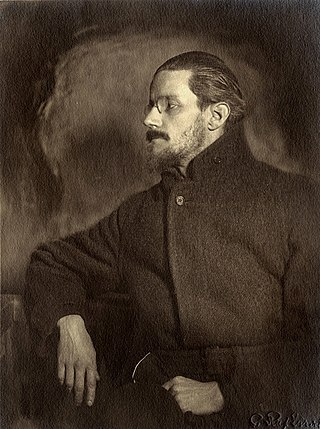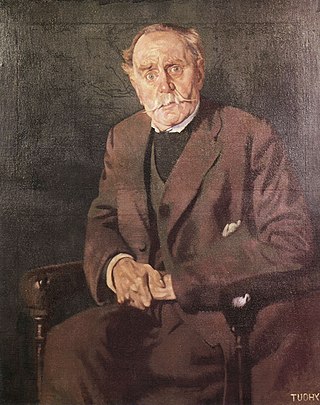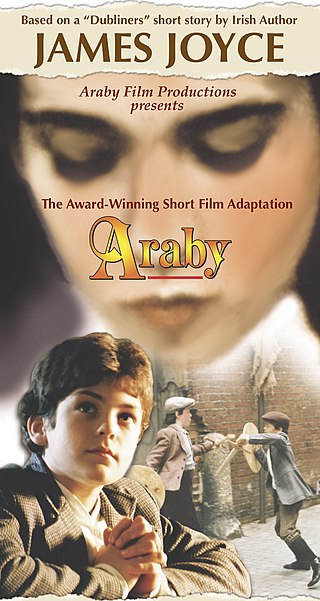
James Augustine Aloysius Joyce was an Irish novelist, poet and literary critic. He contributed to the modernist avant-garde movement and is regarded as one of the most influential and important writers of the 20th century. Joyce's novel Ulysses (1922) is a landmark in which the episodes of Homer's Odyssey are paralleled in a variety of literary styles, particularly stream of consciousness. Other well-known works are the short-story collection Dubliners (1914), and the novels A Portrait of the Artist as a Young Man (1916) and Finnegans Wake (1939). His other writings include three books of poetry, a play, letters, and occasional journalism.

Leopold Bloom is the fictional protagonist and hero of James Joyce's 1922 novel Ulysses. His peregrinations and encounters in Dublin on 16 June 1904 mirror, on a more mundane and intimate scale, those of Ulysses/Odysseus in Homer's epic poem: The Odyssey.

A Portrait of the Artist as a Young Man is the debut novel of Irish writer James Joyce, published in 1916. A Künstlerroman written in a modernist style, it traces the religious and intellectual awakening of young Stephen Dedalus, Joyce's fictional alter ego, whose surname alludes to Daedalus, Greek mythology's consummate craftsman. Stephen questions and rebels against the Catholic and Irish conventions under which he has grown, culminating in his self-exile from Ireland to Europe. The work uses techniques that Joyce developed more fully in Ulysses (1922) and Finnegans Wake (1939).

Stephen Dedalus is James Joyce's literary alter ego, appearing as the protagonist and antihero of his first, semi-autobiographic novel of artistic existence, A Portrait of the Artist as a Young Man (1916), and as a major character in his 1922 novel Ulysses. Stephen mirrors many facets of Joyce's own life and personality. Joyce was a talented singer, for example, and in Ulysses Leopold Bloom notes the excellence of Stephen's tenor voice after hearing him sing Johannes Jeep's song "Von der Sirenen Listigkeit".

Roderick Doyle is an Irish novelist, dramatist and screenwriter. He is the author of eleven novels for adults, eight books for children, seven plays and screenplays, and dozens of short stories. Several of his books have been made into films, beginning with The Commitments in 1991. Doyle's work is set primarily in Ireland, especially working-class Dublin, and is notable for its heavy use of dialogue written in slang and Irish English dialect. Doyle was awarded the Booker Prize in 1993 for his novel Paddy Clarke Ha Ha Ha.

Dubliners is a collection of fifteen short stories by James Joyce, first published in 1914. It presents a naturalistic depiction of Irish middle class life in and around Dublin in the early years of the 20th century.

John Stanislaus Joyce was the father of writer James Joyce, and a well known Dublin man about town. The son of James and Ellen Joyce, John Joyce grew up in Cork, where his mother's family, which claimed kinship to "Liberator" Daniel O'Connell, was quite prominent.
"The Dead" is the final short story in the 1914 collection Dubliners by James Joyce. It is by far the longest story in the collection and, at 15,952 words, is almost long enough to be described as a novella. The story deals with themes of love and loss, as well as raising questions about the nature of the Irish identity.
"Eveline" is a short story by the Irish writer James Joyce. It was first published in 1904 by the journal Irish Homestead and later featured in his 1914 collection of short stories Dubliners. It tells the story of Eveline, a teenager who plans to leave Dublin for Argentina with her "lover".
"Araby" is a short story by James Joyce published in his 1914 collection Dubliners. The story traces a young boy's infatuation with his friend's sister.
"A Little Cloud" is a short story by James Joyce, first published in his 1914 collection Dubliners. It contrasts the life of the protagonist, Little Chandler, a Dubliner who remained in the city and married, with the life of his old friend Ignatius Gallaher, who had left Ireland to find success and excitement as a journalist and bachelor in London.
"The Sisters" is a short story by James Joyce, the first of a series of short stories called Dubliners. Originally published in the Irish Homestead on 13 August 1904, "The Sisters" was Joyce's first published work of fiction. Joyce later revised the story and had it, along with the rest of the series, published in book form in 1914. The story details a boy's connection with a local priest, in the context of the priest's death and reputation.

"Clay" is a short story by James Joyce published in his 1914 collection Dubliners. It deals with the reflections of a middle-aged, unmarried woman during the course of her day.
"A Painful Case" is a short story by Irish author James Joyce published in his 1914 collection Dubliners. The story details a platonic affair between an isolated man and a married woman, the breaking off of the affair, and its aftermath.
"Ivy Day in the Committee Room" is a short story by James Joyce published in his 1914 collection Dubliners. Taking place in a political party office after a day of canvassing, the story depicts various campaigners discussing the political candidates and issues of Irish nationalism and Home Rule. "Ivy Day" refers to an Irish holiday that commemorated Charles Stewart Parnell, an important Irish nationalist figure.
"Grace" is a short story by James Joyce written toward the end of 1905 and published in his 1914 collection Dubliners.
"Two Gallants" is a short story by James Joyce published in his 1914 collection Dubliners. It tells the story of two Irishmen who are frustrated with their lack of achievement in life and rely on the exploitation of others to live. Joyce considered the story to be one of the most important in Dubliners.
Epiphany in literature refers generally to a visionary moment when a character has a sudden insight or realization that changes their understanding of themselves or their comprehension of the world. The term has a more specialized sense as a literary device distinct to modernist fiction. Author James Joyce first borrowed the religious term "Epiphany" and adopted it into a profane literary context in Stephen Hero (1904–1906), an early version of A Portrait of the Artist as a Young Man. In that manuscript, Stephen Daedalus defines epiphany as "a sudden spiritual manifestation, whether in the vulgarity of speech or of gesture or in a memorable phase of the mind itself." Stephen's epiphanies are moments of heightened poetic perception in the trivial aspects of everyday Dublin life, non-religious and non-mystical in nature. They become the basis of Stephen's theory of aesthetic perception as well as his writing. In similar terms, Joyce experimented with epiphany throughout his career, from the short stories he wrote between 1898 and 1904 which were central to his early work, to his late novel Finnegans Wake (1939). Scholars used Joyce's term to describe a common feature of the modernist novel, with authors as varied as Virginia Woolf, Marcel Proust, Ezra Pound, and Katherine Mansfield all featuring these sudden moments of vision as an aspect of the contemporary mind. Joycean or modernist epiphany has its roots in nineteenth-century lyric poetry, especially the Wordsworthian "spots of time," as well as the sudden spiritual insights that formed the basis of traditional spiritual autobiography. Philosopher Charles Taylor explains the rise of epiphany in modernist art as a reaction against the rise of a "commercial-industrial-capitalist society" during the early twentieth century.

Araby is an independent short film directed by Dennis Courtney, starring Van Hughes. It was adapted from the short story "Araby" by James Joyce, which was included in his short works collection Dubliners.
Sister Mary Gertrude Joyce was an Irish Sisters of Mercy nun and musician.







